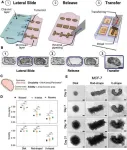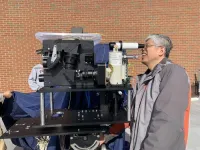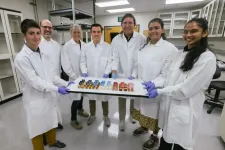(Press-News.org) Exposure to blue light, like that from smartphones or tablets, may accelerate bone growth and bone age, leading to early puberty in rats. This research, presented at the 62nd Annual European Society for Paediatric Endocrinology Meeting in Liverpool, sheds light on how the use of blue light-emitting devices could impact growth and development and raises important questions about the long-term health effects in children, who are increasingly exposed to screens from a young age.
As children grow and develop, long bones such as the femur progressively elongate at each end. These growing ends – areas of smooth, elastic cartilage known as ‘growth plates’ – eventually solidify which stops growth in height. Girls generally stop growing and reach their maximum height between ages 14 and 16, while boys finish their growth between 16 and 18 years of age. However, in recent years, several studies have reported a rise in early puberty in both girls and boys, in which they might grow quickly at first but often stop growing earlier than usual. One factor may be the increased use of blue light-emitting devices.
In this study, researchers from Gazi University in Turkey examined 18 male and 18 female rats aged 21-days-old, equally divided into three groups of six and exposed to either a normal light cycle, six hours or 12 hours of blue light until the first signs of puberty. They measured their length and femurs and found that the rats exposed to blue light had a faster growth, particularly in their bones, and started puberty earlier compared to those in standard light conditions.
Previous research from the same group has also shown that rats exposed to blue light have a higher risk of early puberty. However, this association has never been studied in bone growth and pubertal development before. “This is the first study to show how blue light could potentially influence physical growth and development, prompting further research into the effects of modern screen exposure on children’s growth,” said lead researcher Dr Aylin Kılınç Uğurlu.
Although Dr Kılınç Uğurlu warned: “As this a rat study, we cannot be sure that these findings would be replicated in children but our data suggest that prolonged exposure to blue light accelerates both the physical growth and maturation of the growth plate, leading to early puberty.”
“While the increased growth may sound beneficial, our study also found that blue light exposure led to earlier structural changes in the growth plates of the rats’ bones, suggesting an impact on long-term bone age,” said Dr Kılınç Uğurlu. “This means their bones matured too soon which could potentially cause them to be shorter than average as adults.”
The researchers are now planning to investigate how blue light exposure before puberty affects height and skeletal development in adult rats. “We want to explore the long-term effects of pre-pubertal blue light exposure and find out whether certain exposure durations or intensities have reversible or permanent effects on the skeleton later in life,” said Dr Kılınç Uğurlu. “Ultimately, this research could lead to preventative measures for safe screen use during childhood development.”
END
Excessive screen time linked to early puberty and accelerated bone growth
2024-11-16
ELSE PRESS RELEASES FROM THIS DATE:
First nationwide study discovers link between delayed puberty in boys and increased hospital visits
2024-11-16
Swedish young men who went through late puberty during adolescence are more likely to use healthcare services later in life, according to research presented at the 62nd Annual European Society for Paediatric Endocrinology Meeting in Liverpool. The findings of this long-term study suggest that delayed puberty in boys may have harmful effects on their health in adulthood and could potentially lead to new follow-up healthcare routines in the future.
Puberty in boys typically starts between the ages of 9 and 14. However, about 2% of boys have delayed puberty, in which puberty does not begin by age 14. In most cases, delayed puberty is constitutional – a pattern of growth and development ...
Traditional Mayan practices have long promoted unique levels of family harmony. But what effect is globalization having?
2024-11-16
A new paper in the journal Child Development shows how some aspects of family interaction among Indigenous people in Guatemala have fundamentally shifted with rapid globalization, yet families have still maintained a unique level of harmony in their interactions.
UC Santa Cruz psychologist Barbara Rogoff has been working with Mayan communities in San Pedro la Laguna, Guatemala for five decades and noticed a sophisticated type of fluid, inclusive collaboration among children from these communities. During a research study 30 years ago, mothers and their two small children interacted in a very distinct way, ...
New microfluidic device reveals how the shape of a tumour can predict a cancer’s aggressiveness
2024-11-15
Researchers at the University of Toronto’s Faculty of Applied Science & Engineering have designed a new microfluidic platform that allows forunprecedented control and manipulation of tumor shapes — a largely unexplored area with great potential to advance cancer research.
The work, led by Professor Edmond Young, offers new insights into how the shape of tumours can predict cancer cell behaviour and aggressiveness, which opens new pathways for more personalized and targeted cancer care.
“While there are several platforms for in vitro modelling of spheroids — ...
Speech Accessibility Project partners with The Matthew Foundation, Massachusetts Down Syndrome Congress
2024-11-15
The Speech Accessibility Project has two new partners — The Matthew Foundation and the Massachusetts Down Syndrome Congress — as it continues to recruit adults with Down syndrome who live in the United States and Canada. The project also allows residents of Puerto Rico to participate.
The project is also recruiting those with ALS, cerebral palsy and Parkinson’s disease, as well as individuals who have had a stroke.
“The research team has learned that connecting with trusted partners is key to showing the credibility of our work and how much it could improve the lives of people with disabilities,” said Mark ...
Mass General Brigham researchers find too much sitting hurts the heart
2024-11-15
Fitting in a workout after a long day of sitting at a desk might not be enough to compensate for the impacts of sedentary behavior on the heart. Investigators from Mass General Brigham, found that excessive sedentary behavior (waking activity with low energy expenditure while sitting, reclining, or lying down and not including hours spent sleeping at night) was linked to increased risk of heart disease, especially heart failure and cardiovascular death, and that these risks could be significantly reduced by substituting sedentary time for other activities. They also found that meeting guideline levels of moderate-to-vigorous physical activity may be insufficient on its own to reduce cardiovascular ...
New study shows how salmonella tricks gut defenses to cause infection
2024-11-15
A new UC Davis Health study has uncovered how Salmonella bacteria, a major cause of food poisoning, can invade the gut even when protective bacteria are present. The research, published in the Proceedings of the National Academy of Sciences, explains how the pathogen tricks the gut environment to escape the body's natural defenses.
The digestive system is home to trillions of bacteria, many of which produce short-chain fatty acids (SCFAs) that help fight harmful pathogens. But Salmonella manages to grow and spread in the gut, even though ...
Study challenges assumptions about how tuberculosis bacteria grow
2024-11-15
The rod-shaped tuberculosis (TB) bacterium, which the World Health Organization has once again ranked as the top infectious disease killer globally, is the first single-celled organism ever observed to maintain a consistent growth rate throughout its life cycle. These findings, reported by Tufts University School of Medicine researchers on November 15 in the journal Nature Microbiology, overturn core beliefs of bacterial cell biology and hint at why the deadly pathogen so readily outmaneuvers our immune system and antibiotics.
"The ...
NASA Goddard Lidar team receives Center Innovation Award for Advancements
2024-11-15
NASA researchers Guan Yang, Jeff Chen, and their team received the 2024 Innovator of The Year Award at the agency’s Goddard Space Flight Center in Greenbelt, Maryland, for their exemplary work on a lidar system enhanced with artificial intelligence and other technologies.
Like a laser-based version of sonar, lidar and its use in space exploration is not new. But the lidar system Yang and Chen’s team have developed — formally the Concurrent Artificially-intelligent Spectrometry and Adaptive Lidar System (CASALS) — can produce higher resolution data within a smaller space, significantly increasing efficiency compared to current models.
The ...
Can AI improve plant-based meats?
2024-11-15
Cutting back on animal protein in our diets can save on resources and greenhouse gas emissions. But convincing meat-loving consumers to switch up their menu is a challenge. Looking at this problem from a mechanical engineering angle, Stanford engineers are pioneering a new approach to food texture testing that could pave the way for faux filets that fool even committed carnivores.
In a new paper in Science of Food, the team demonstrated that a combination of mechanical testing and machine learning can describe food texture with striking similarity to human taste testers. Such a method could speed up the development of new and better plant-based meats. The team also found that ...
How microbes create the most toxic form of mercury
2024-11-15
Mercury is extraordinarily toxic, but it becomes especially dangerous when transformed into methylmercury – a form so harmful that just a few billionths of a gram can cause severe and lasting neurological damage to a developing fetus. Unfortunately, methylmercury often makes its way into our bodies through seafood – but once it’s in our food and the environment, there’s no easy way to get rid of it.
Now, leveraging high-energy X-rays at the Stanford Synchrotron Radiation Lightsource (SSRL) at the U.S. Department of Energy’s SLAC National Accelerator Laboratory, ...


